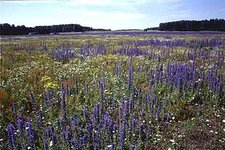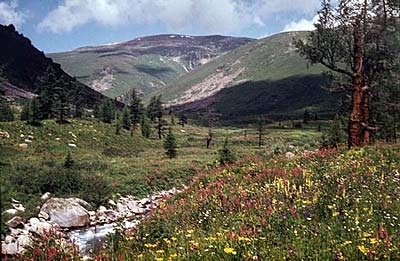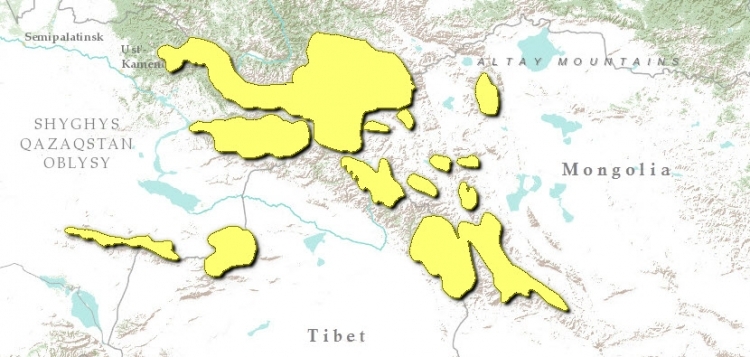Altai alpine meadow and tundra
The Altai Mountain Range forms a biogeographic divide between Siberia and the desert basins of Central Asia, and represents a center of biodiversity for many plant and animal taxa. Its coniferous forests and extensive alpine landscapes serve as the source of two of Siberia’s greatest rivers, the Ob and the Irtysh. UNESCO nominated the north Altai as a World Heritage Site in 1998, as it represents a complete sequence of altitudinal vegetation zones in central Siberia including steppe, forest-steppe, mixed forest, sub-alpine vegetation and alpine vegetation. The region is also an important habitat for endangered the snow leopard and its prey.
Location and General Description
The Altai are the most northerly mountains of Central Asia, dividing the hills and plains of western Siberia from dry basins to the south. Rivers flowing from the north slope merge with the Ob, a principal waterway of Siberia and, from its source to its mouth in the Arctic Ocean, one of the longest rivers in the world. Because of their high latitude (48o to 52o N), these mountains have an arctic character distinct from the Tian Shan, Himalaya and Tibetan regions to the south. Of 300 plant species surveyed, 39 percent have an arctic affinity while the remaining 61 percent are more closely allied with the plants of montane Central Asia. Although elevations here are lower than other mountain ranges of Central Asia (the highest peak is 4,506 meters (m)), the elevation of the alpine zone is also lower. Treeline is no higher than 2,400 meters (m), and high alpine landscapes of permanent ice, rock, and scree are present above 3,000 m. This ecoregion occupies the extensive upland area that is situated between treeline and the high alpine landscapes. It also includes those areas below treeline which support alpine meadow vegetation.
To the north and west, the Altai adjoin the Sayan Mountains and the steppes of western Siberia. To the south and east, they merge with the ranges of western Mongolia and the lower mountains that define the western edge of the Junggar Basin. Because they are separated from the arctic only by 1,600 kilometers (km) of Siberian lowlands, the Altai receive more precipitation than the other mountain ranges of Central Asia. Annual totals range from 250 millimeters (mm) at the lower elevations to 500 mm at 3,000 m, and, because the climate is cold, rates of evaporation are also lower than in the desert ranges to the south. Thus, water is an important component of the landscape with many rivers, lakes, and marshy tundra [[region]s]. While summers are temperate, winters are very cold. Minimum temperatures of –62o Celcius (C) have been recorded here.
The extensive highland area, with cold temperatures and short growing season, supports alpine meadows and tundra, a vegetation type that constitutes a primary component of the Altai landscape. High plateaus extend for hundreds of square kilometers with lichens and mosses as the principal ground cover. Below 2,400 m, subalpine conifer forests cover a large area. Dominant tree species here are Siberian larch (Larix sibirica) and Siberian fir (Abies siberica). Stands of these trees are part of a mosaic landscape that also includes meadow with an alpine component. Thus, at its lower margin, the distinction between the [[ecoregion]s] Altai Alpine Meadow and Tundra and Altai Montane Forest and Forest Steppe tends to blur.
Dominant tundra ground cover in the Altai consists of mosses and fungi as well as a small number of vascular plants well-adapted to this extreme environment. Cushion plants are dominant in ice-free areas above 3,500 m. Slightly lower elevations support alpine meadows dominated in the wetter northwest by dwarf birch (Betula rotundifolia) and in the drier southeast by sedge-meadows of Kobresia and Carex. In contrast, the alpine meadows (interspersed among stands of conifer forest) are dominated by grasses such as Stipa, Festuca, and Poa and colorful alpine forbs such as Viola, Silene, and Aquilegia. Thickets of Rhododendron also occur in some areas.
Biodiversity Features
 Yaks (Bos grunniens) at 2400m in the Altai Mountains, Mongolia. (Photograph by © WWF-Canon/Hartmut Jungius
Yaks (Bos grunniens) at 2400m in the Altai Mountains, Mongolia. (Photograph by © WWF-Canon/Hartmut Jungius In Russia, the Altai population of endangered snow leopards (Panthera uncia) is one of the largest among the mountains of southwestern Siberia. Other mammals of special significance include lynx (Felis lynx) and musk deer (Moschus moschiferus), both of which dwell in conifer forest and venture into scrubby or rocky alpine habitats. Because the Altai constitute an important biogeographic barrier, their northern slopes provide habitat for some circumpolar mammal species, such as reindeer (Rangifer tarandus). Small mammals characteristic of alpine environments include Altai pika (Ochotona alpina), arctic ground squirrel (Citellus undulatus), and Siberian chipmunk (Tamias sibiricus).
A total of 13 species of birds and four species of mammals are listed in the Red Data Book of the Russian Federation. Among listed birds and mammals are: golden eagle (Aquila chrysaetus), imperial eagle (Aquila heliaca), peregrine (Falco peregrinus), black-winged stilt (Himantopus himantopus), snow leopard (EN, globally threatened), manul cat (Felis manul), Mongolian gazelle (Procapra guttorosa), relict gull (Larus relictus), and Altai argali (Ovis ammon ammon). Among other listed species of fauna are species endemic to the area: gryfalcon (Falco altaicus) and Siberian zokor (Myospalax myospalax).
A single mammal, a type of birch mouse Sicista pseudonapaea, is endemic to this ecoregion. Birch mice inhabit forests, subalpine meadows, and steppes.
Current Status
 Eastern Altai, Russia. (Photograph by O. Kosterin)
Eastern Altai, Russia. (Photograph by O. Kosterin) Much of the ecoregion, especially on the northern (Russian) side remains quite pristine, and access to the whole mountain region remains difficult. Its position on the border of four countries probably has the effect of slowing the pace of development, although mining occurs in some areas.
Types and Severity of Threats
Grazing and hunting, both for meat and as a response to livestock depredation, is likely to threaten some of the mammals here.
The Altai Mountains present a landscape that is very scenic with parklike alpine landscapes, dense forests and glacially scoured lake-filled basins. Should access to this area increase in the future, it will certainly become attractive for all kinds of mountain tourism, with its attendant ecological costs and benefits.
Justification of Ecoregion Delineation
These high elevation grasslands include the tundra and cryophytic meadows of the North Altai and Altai-Saur-Tarbagatai regions according to Pereladova’s map of Central Asian ecosystems. In Russia, the boundaries correspond to the montane tundra in the West Siberian vegetation province in Kurnaev’s forest map of the USSR. High mountain areas of Mongolian Altai, as defined by the Mongolia Ministry for Nature and Environment, are also included.
Additional information on this ecoregion
- For a shorter summary of this entry, see the WWF WildWorld profile of this ecoregion.
- To see the species that live in this ecoregion, including images and threat levels, see the WWF Wildfinder description of this ecoregion.
- World Wildlife Fund Homepage
Further Reading
- Government of Mongolia. 1996. Biodiversity conservation action plan for Mongolia.
- Knystautas, A. 1987. The natural history of the USSR. McGraw-Hill Book Company, New York. ISBN: 007035409X
- Kurnaev, S. 1990. Forest regionalization of the USSR (1:16,000,000). Department of Geodesy and Cartography, Moscow.
- MacKinnon, J., M. Sha, C. Cheung, G. Carey, Z. Xiang, and D. Melville. 1996. A biodiversity review of China. Worldwide Fund for Nature (WWF) International, Hong Kong.
- Mongolia Ministry for Nature and Environment, United Nations Development Programme (UNDP)/Global Environment Facility (GEF), and World Wide Fund for Nature (WWF). 1996. Mongolia’s Wild Heritage, edited by C. Finch. Avery Press, Boulder
- Pereladova, O., V. Krever, and M. Williams. editors. 1997. Biodiversity conservation in central Asia – Analysis of Modern Situation and Project Portfolio. WWF.
- United Nations Educational, Scientific, and Cultural Organization. Golden Mountains of Altai World Heritage Site]. Retrieved (2000)
- United Nations Environment Program. World Conservation Monitoring Centre. Retrieved (2000)
- Zhao, J., Z. Guangmei, W. Huadong, and X. Jialin. 1990. The natural history of China. McGraw Hill Publishing Company, New York. ISBN: 0070107521
| Disclaimer: This article is taken wholly from, or contains information that was originally published by, the World Wildlife Fund. Topic editors and authors for the Encyclopedia of Earth may have edited its content or added new information. The use of information from the World Wildlife Fund should not be construed as support for or endorsement by that organization for any new information added by EoE personnel, or for any editing of the original content. |

